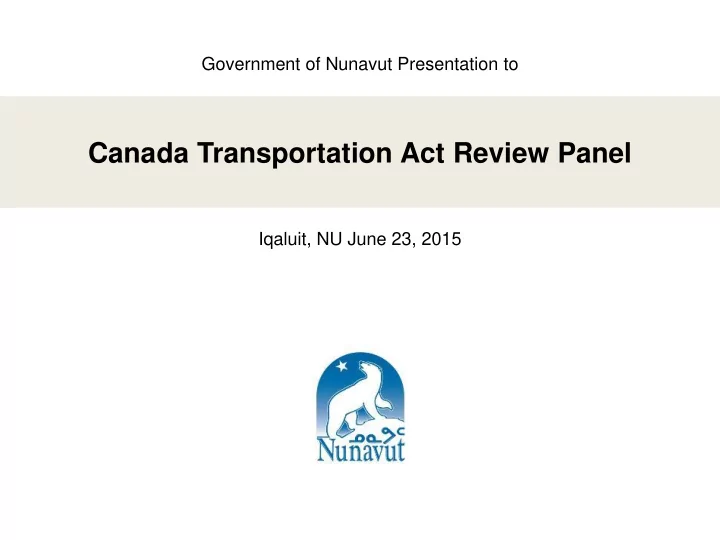

Government of Nunavut Presentation to Canada Transportation Act Review Panel Iqaluit, NU June 23, 2015
Presentation Content • Our Land & People • Our Air System • Our Marine System • Our Highway System • For the Panel’s Consideration • Conclusion
Our Land
Our People
Nunavut Air Transportation System
Nunavut Air Transportation System
Nunavut Air Transportation System
Nunavut Air Transportation System (Iqaluit International Airport Improvement Project)
Nunavut Air Transportation System (Pangnirtung Airport Relocation Project)
Our Marine System
Our Marine System
Our Marine System (Proposed Pond Inlet Marine Infrastructure Project)
Our Marine System (Proposed Pond Inlet Marine Infrastructure Project)
Our Marine System (Proposed Iqaluit Marine Infrastructure Project)
Our Highway System
Our Highway System
Our Highway System
For the Panel’s Consideration What are the overall and long-term priorities for supporting Northern aviation and improving the productivity of the Northern aviation industry to benefit businesses and Northerners? • Have paved runway and apron surfaces at all major hub/regional centre airports • Have all Nunavut airports upgraded to the GPS Instrument Approach Procedure that is appropriate for each individual airport. • Have formal monitoring process available to establish economic consequences of airline code share and/or other market partnerships • Expand the funding for the Transport Canada Airport Capital Assistance Program and a dedicated “carve - out” for northern jurisdictions
For the Panel’s Consideration How adaptation and resilience measures should be developed to address the challenges of climate change and take advantage of any opportunities, including related to permafrost degradation and melting sea ice? • Through continued Transport Canada sponsorship of the Permafrost Network of Excellence and current membership structures • Through continued Transport Canada sponsorship of the Network of Expertise on Transportation in Arctic Waters and current membership structures
For the Panel’s Consideration How and to what degree should the federal government support the northern transportation system to facilitate resource developments and are there strategic ways in which projects can be prioritized and advanced? PART ONE • Insufficient, aging and non-existent infrastructure has long been considered a hurdle for quality of life improvements throughout Nunavut and has proven to be a significant stumbling block for a multitude of resource development proponents in northern and remote regions with projects that do not have direct access to tidewater. • In the Arctic, the challenges of developing base metal mines is further exacerbated by the Arctic cost premium which represents the incremental cost of arctic mine development relative to similar mine developments in more southerly locations. Analyses completed by industry and industry associations indicate that it is 200% more expensive to build and 30% more expensive to operate projects in the arctic relative to other more southerly jurisdictions.
For the Panel’s Consideration How and to what degree should the federal government support the northern transportation system to facilitate resource developments and are there strategic ways in which projects can be prioritized and advanced? PART TWO • The “Levelling the Playing Field” produced by a number of Canadian mining/mineral groups and organizations clearly demonstrates that the cost premium for both exploration and mining is directly linked to the transportation deficit in remote and Northern Canada. For example, the report references that the average costs of very remote projects (more than 500km from a supply route) were, on average, 2.8 times higher than non-remote projects. • These “transformational projects” can unlock the tremendous opportunities available to Nunavut and drive capacity development and economic growth in the region for decades to come. Inuit employment and Nunavut GDP growth should be priorization considerations
For the Panel’s Consideration What are the long-term approaches and strategies that need to be put in place to ensure that marine navigation, safety and responsiveness is appropriate for shipping in the North? • Reinstate the CCG program for sealift/resupply support • Need for long term icebreaker deployment strategy • Undertake new hydrographic surveys on various approaches to resupply sites and marine transportation corridors • New port infrastructure in Nunavut communities that could support regular use by federal patrol and research vessels and additional emergency response capacity for situations where community members, recreational travelers or commercial vessels require assistance or medical support
For the Panel’s Consideration What can be done and/or put in place for the northern transportation system to better support Canada’s sovereignty in the North? • Development of port infrastructure in Nunavut communities that could support regular use by federal patrol and research vessels. Pond Inlet, Iqaluit and Grays Bay offer opportunities. • Additional runway lengthening and paving at Nunavut airports to support newer and larger jet/turbo prop cargo capable aircraft. • Additional all-weather road access to the Arctic coast that could serve both communities and resource development
Summary • Nunavut has challenges similar to other northern regions when it comes to managing and developing transportation infrastructure . Aging infrastructure, permafrost degradation, high construction costs, short construction season, budgetary constraints and harsh climate conditions are the main barriers to the realization • The challenges are many; but in partnership with Canada, and building on the strength and energy of its resilient people, Nunavut looks to the future with confidence and hope.
Qujannamiik Thank You
Recommend
More recommend